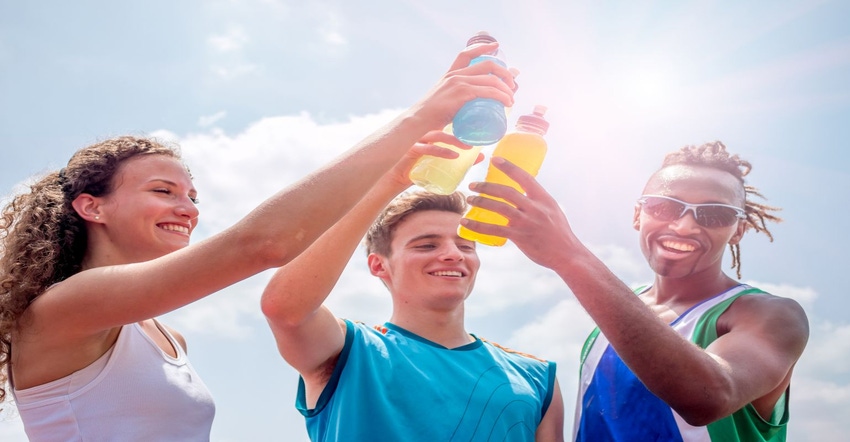Sports drink demographics and desires expand
A ready-to-drink (RTD) sports beverage will best reach the expanding range of active consumers when a brand understands the objectives of its target demographic.

Ready-to-drink (RTD) beverages for sports and active nutrition abound today in all varieties: Energy drinks, sports drinks, wellness beverages, meal replacement, vitamin/mineral waters and other flavored waters. For active consumers, RTDs can either be a refreshing thirst quencher, an easy pick-me-up, or a functional beverage that offers a “little something extra” to help get them through their day.
Athletes and others who are health-conscious are turning to products with further well-being properties—people who like to experiment are opting for special flavors and innovative ingredients, while athletes have always sought high-protein beverages or isotonic drinks. Yet, the boundaries between traditional target groups are increasingly blurring.
Sport drinks market
Mordor Intelligence reported a global compound annual growth rate (CAGR) of around 12.2% for the entire sports nutrition sector during the next five years, with the beverages segment charting the highest sales. Weekend warriors are rounding out the target audience of sports professionals, ambitious amateurs and simply busy, active people. These consumers expect performance from RTD beverages with a positive health benefit.
Healthy, functional, tasty
To effectively reach these new target groups, understanding their objectives is important. Whereas professional athletes need to prepare their bodies for extreme stress situations with special foods and beverages tailored to their needs—or quickly replenish their energy and mineral stores during and after training with isotonic drinks—typical exercisers are generally more interested in getting their bodies in better shape with a moderate level of activity. At the same time, those who hope to get more and longer-lasting energy for their everyday lives are turning to fitness drinks, as opposed to the quick-fix caffeine kick, for example, that numerous energy drinks offer.
Now, though, RTD sports products must also deliver in terms of taste. Protein beverages have a come a long way from their original offerings, as far as their mouthfeel and flavor. Today, protein-enriched drinks are, quite literally, on everyone’s lips. Expectations are rising and manufacturers are looking for new ways to compensate for sensory disadvantages, particularly related to plant-based protein enrichment and high-intensity sweeteners with masking ingredients, as well as introducing new flavors and additional functional ingredients for the category in general.
Last but not least, and for several reasons, manufacturers of RTD sports drinks for general consumer use need to keep an eye on carbohydrates, and specifically on sugars. Whereas athletes primarily understand that sugars and other carbs act as proven sources of energy, conventional sugar and thus “added sugar” in Nutrition Facts labels is one of the ingredients that typical consumers are wary of. Although sugars are often perceived to be associated with negative health consequences, they are also a key energy source the body can use to function.
Education and product messaging may be part of the solution. A 2020 Insites Consulting survey of 5,000 consumers in Spain, France, Germany, Poland and the U.K. showed that 1 in 3 consumers lack energy during the day and seek food and beverages to counteract it. The survey also indicated that 8 out of 10 young adults (18- to 34-year-olds) are reaching for energy-boosting products.
Long-term energy overcomes short-term performance
Although RTD sports drinks have become more popular, many still contain classic energy sources—high-glycemic carbohydrates such as maltodextrin, sucrose or glucose syrup—which would not be fitting for the average consumer. High-glycemic ingredients are broken down shortly after entering the small intestine and cause the glucose level in the blood to rise rapidly after consumption. This can be useful, for example, as an “instant” energy boost during a sprint event or intense training sessions, but unhealthy for someone sitting at a desk during their work day.
Especially for active consumers who go to the gym to get their bodies in better shape or lose weight, the employee under duress, the student taking exams, or busy parents managing both work and home life with children, strong fluctuations in blood sugar levels are not ideal. If blood sugar rises sharply due to high glycemic ingredients, the body releases more insulin to transport this sugar into its cells. Consequently, blood sugar level drops just as rapidly. As a result, performance suffers, consumers feel exhausted and yet the body demands a replenishment—the well-known “sugar spike and crash” effect.
A fully digestible carbohydrate with a low glycemic index (GI) can counteract this spike-and-crash effect via a slow and steady release of glucose, which keeps insulin levels low and provides an overall positive effect on blood sugar. Glucose is the main fuel for body and brain.
Sport drinks for improved fat metabolism
High glucose levels and elevated insulin concentrations have another disadvantage: They inhibit the body’s ability to burn its own fat stores. Studies have shown that sports drinks with slow-release carbohydrates instead of conventional sugars and/or other rapidly available carbohydrates increase the fat-burning rate and performance of endurance athletes (Nutrients. 2016;8[7]:390). Study participants who consumed an RTD beverage with a low-glycemic sugar had a consistently more stable blood sugar concentration during the entire training period—owing to a less intense initial blood sugar spike—and, therefore, lower blood insulin levels. This metabolic change caused a shift from carbohydrate burning to fat oxidation.
Constant osmolality for isotonic beverages
As a specialized category, isotonic sports drinks should contain the same content of minerals, carbohydrates and vitamins as human blood, which allows the supplied nutrients to be absorbed faster and in a better way by the body. In this context, osmolality refers to the number of dissolved particles per kilogram of fluid. This ratio should remain constant until the best-before date of a product to preserve the claimed benefit for the end user.
Studies have shown—and the extensive handbook “Alternative Sweeteners” details—that shelf-stable beverages with a low-glycemic carbohydrate resistant to acid hydrolysis have a constant osmolality, even under different environmental conditions. This is an advantage, for example, compared with sucrose-sweetened beverages, the osmolality of which can vary. This makes it easier to claim the benefits of the specific particle concentration of the beverage, such as “isotonic.”
The market for sports drinks is growing, which makes for steady competition. Manufacturers of RTD beverages can provide a unique, innovative solution that offers a balanced energy supply, something anyone would love. This leads to functional benefits of sustained energy, improved fat metabolism, blood sugar control and osmolality for isotonic beverages. And to reach a broader base of consumers, of course, incorporating great taste is a must.
To read related content, visit the “Breakthroughs in sports nutrition RTD beverages” digital magazine.
Kyle Krause is the North American regional product manager for functional carbohydrates and fiber at BENEO. He coordinates with the company’s various departments and customers to support sales growth and develop new business by uncovering innovative application areas. Krause joined BENEO in 2006 as a regional sales manager, after five years in technical and sales positions in food industry related companies. He has a bachelor’s degree in food science from Rutgers University, Cook College, and is a member of several food industry organizations including IFT, AACT, PMCA and NCA.
About the Author(s)
You May Also Like






.png?width=800&auto=webp&quality=80&disable=upscale)